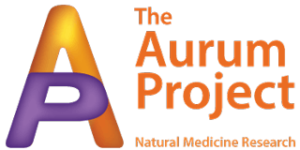Thank you to Sandra Venables for contributing this blog about her experience at the HRI 2025 Conference in Thessaloniki Greece. Sandra holds the position of secretary of Australian Register of Homeopaths (ARoH) and is an Aurum Project Research Pod Member.
Coming to the HRI conference for the first time, the experience did not begin when I first stepped into the registration area, it began with meeting up with many Aurum Project members and ARoH registrants who were already in Thessaloniki. We enjoyed a delightful breakfast at the Beyond the Wall cafe reconnecting with old connections and developing new ones. All this before going our separate ways to explore the city in preparation for the conference experience to truly begin!
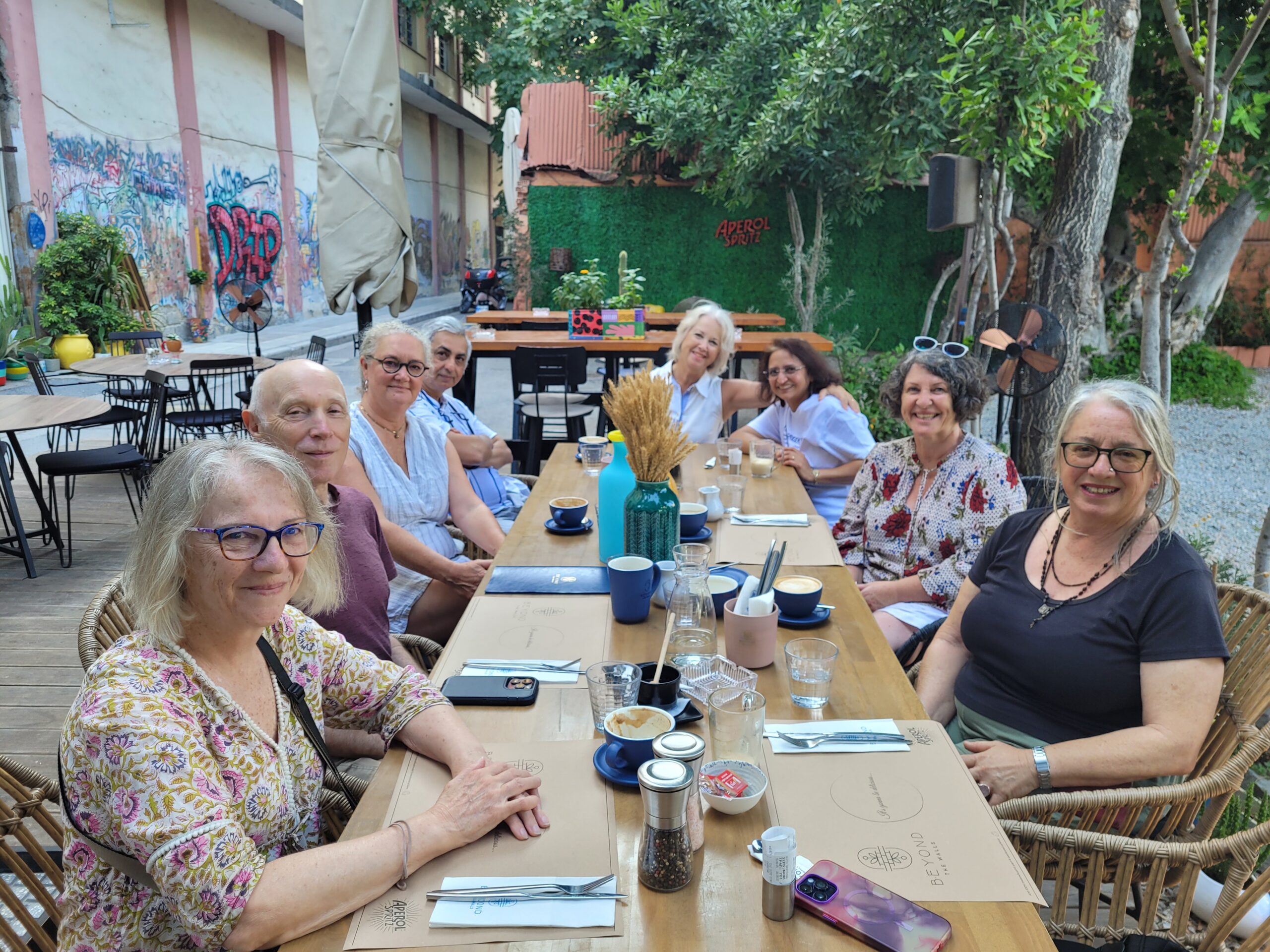
Aurum Project Members at a breakfast meetup before HRI Greece conference
Welcome reception
Thursday evening was the welcome reception, everyone moved onto the terrace after registering and we began the mingle. Again there were relationships being rekindled after two years on opposite sides of the world, work colleagues meeting in person, and the beginning of new friendships from homeopaths around the globe. Meeting homeopaths from Hong Kong, Sweden, Czech Republic, India, New Zealand and Australia soon allowed the time to pass without realising! We all have so much we wish to share it seems. The next three days are exciting to anticipate at this time, while watching the sun set over the bay.
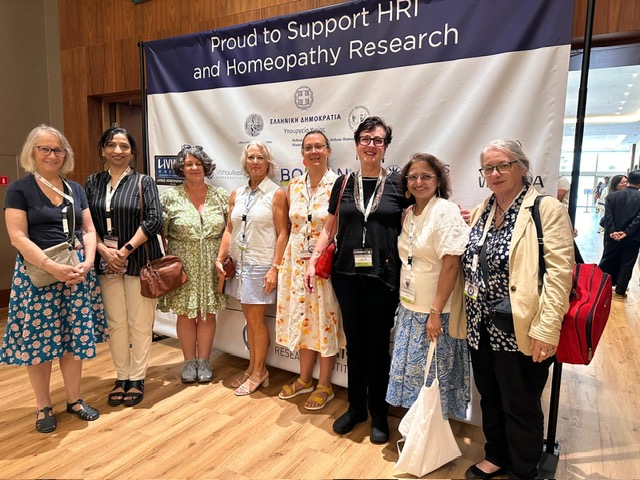
Aurum Project members at HRI conference 2025 Greece. From left to right: Linlee Jordan (AP Director), Dr Sujata Naik (Clinic Director, AP research pod member), Sandra Venables (Australian Register of Homoeopaths ARoH, AP research pod member), Jane Lindsay (AP Vice President), Barbara Roberts (NZ Homeopath, AP member), Virginia Turner (President, Australian Homoeopathic Association), Dr Niri Pandit (AP Assistant Vice President), Lee Formica (AP member, ARoH representative)
Day 1
The opening of the conference gives us all an overview of what is suggested to be themes emerging. These themes we are to look for include agrohomeopathy and addictions! I will also add antimicrobial resistance as a theme that came through clinical research and argrohomeopathy.
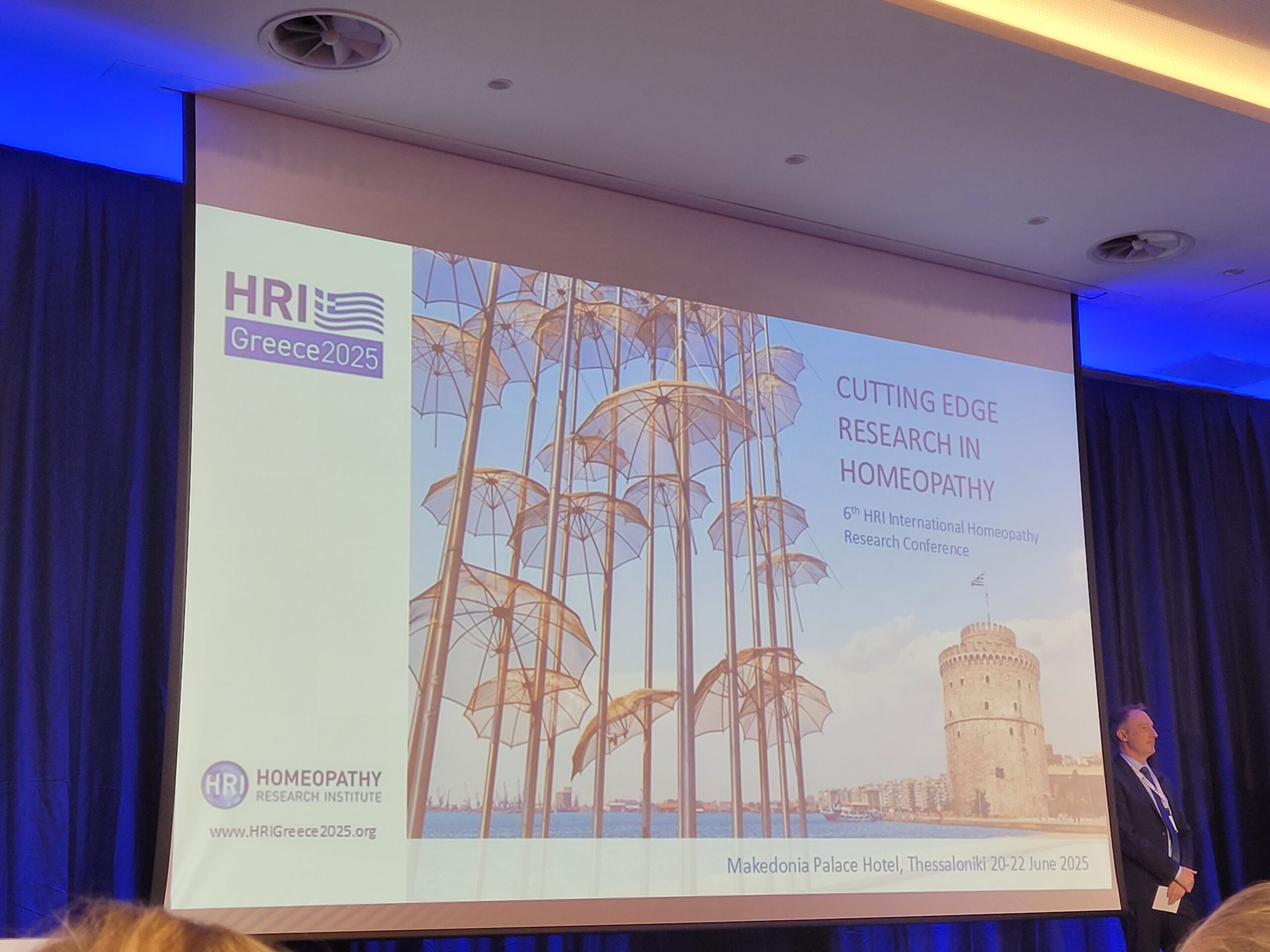
As at any conference, the breaks between sessions are where you share ideas, develop potential partnerships, learn about how homeopathy is practised in a country you may have never considered visiting before today! It is also a time to reconnect, to consolidate and to listen. It seems it is never a time to chill and relax!
Todays sessions covered provings & economics, clinical research and basic research, before the much anticipated poster sessions of which The Aurum Project authored two, one of which was also co-authored by ARoH.
Prof Ross began by asking us if we have ever assessed a patient to require ‘lion’? Did you consider this based on Lac leoninum? Or, did you know about the proving of lion’s claw (Panthera leo)? Which part of the ‘lion’ do you give? Ensuring replication of remedies when the original sample is no longer available is also very important for our pharmacies as well as in clinical practice. It is so important to understand exactly the source of the original substance. Another example, can we replicate the American bald eagle? Are you aware the original source had a broken right wing? Ensuring you follow proving guidelines, whether LMHI-ECH, CCRH or HPUS, it is vital the framework followed is quoted, the exact details and identification of the source, as well as all the details of the proving. To be recognised internationally as homeopaths, we need to be consistent and rigourous.
Onto economics, a topic typically considered ‘dry’ to many. Prof Ostermann ensures we understand that it is vital to record the economy of health care when undertaking trials. It would appear homeopaths first recorded a cost consequence analysis as early as 1843! Of course homeopathy began this at least 100 years before others! However, since approximately 2012, this reporting has reduced. As a modality, it seems we can learn a lot about quality cost effectiveness studies from the study of mindfulness. I recommend you look closely at more than the health outcomes when reporting on the benefit of treatment in a study.
The clinical research session highlighted antibiotic prescription and antimicrobial resistance in acute upper respiratory tract infections, trigeminal neuralgia management (an RCT) and homeopathy as an adjuvant to the treatment of depression. All three studies resulted in conclusions that homeopathy may be beneficial. These studies were undertaken in Germany (Dr Reif), India (Dr Kaur) and Brazil (Prof Adler).
The clinical research was interesting to listen to as there were different methods undertaken in different studies, however positive outcomes were achieved in all.
The basic research session covered the mechanisms of how homeopathy works, include proposed frameworks in a scoping document (Dr Tournier), the inflammatory response to Belladonna on cytokines (Dr Aguilar Duenas), the in vitro effect of Ferrum phosphoricum D12 on mouse macrophages (Assic Prof Tasinov) and the effect of Anas barbariae 200K on phagocytosis (Dr Tribolo).
I find basic research to be inspirational for our industry as there can be no controversy when the trial is replicated without the concept of the placebo effect accounting for results. As technology develops the studies are able to measure the effect on macrophages, cytokines and phagocytosis, where will technology take our profession in the future I ask myself! Very exciting to contemplate this type of research.
To round out day 1 the poster session was held over two hours. Both posters from Australia were well received with many questions from homeopaths around the world. The poster from New Zealand, also on the demograpics and aspects of the industry (Barbara Roberts), was well received also. For the HWFS poster it was incredibly exciting to discuss the results with homeopaths from around the world and understand that there were many similarities amongst most of us! One we must all address is our mature community with limited young practitioners coming through. Sweden and Greece both reflected this issue. This is a very important point for us globally. I greatly appreciated to hear it was not an isolated issue. However, we all took heart from the survey results that indicated how passionate we all are to continue practising as long as we can!
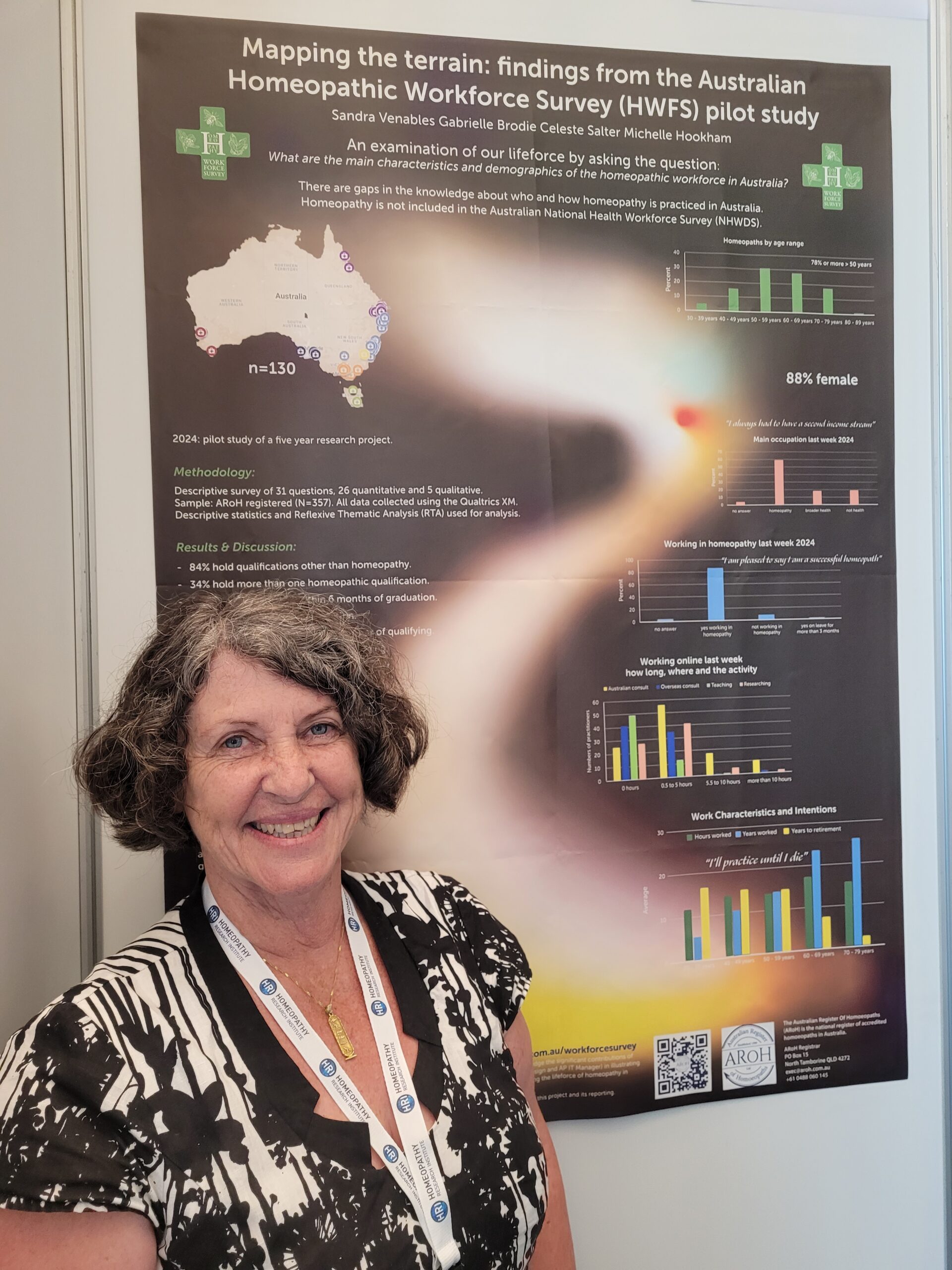
Poster Presentation by Sandra Venables: ‘Mapping the terrain: findings from the Australian Homeopathic Workforce Survey (HWFS) pilot study’ Conducted by: Venables, S, G Brodie, C Salter, and M Hookham. This year’s survey is currently active – We encourage Australian homeopaths to include their responses for this year here https://aroh.com.au/workforcesurvey
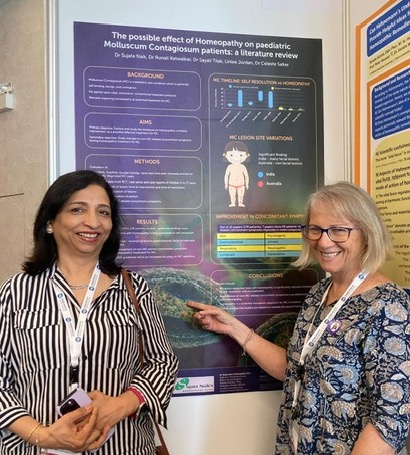
Poster Presentation by Dr Sujata Naik and Linlee Jordan: ‘The possible effect of homeopathy on paediatric molluscum contagiosum patients: a literature review’ Conducted by: Jordan, L, S Naik, S Tilak, R Kelwalkar, and C Salter
Day 2
Today started with the growing area of agrohomeopathy
It was inspiring to learn how Brazilian farmers are embracing homeopathy, for the whole system, embracing soil, water, plants, animals and people. Dr Pedro Boff provided us with statistics such as 20 million cattle are treated annually with homeopathy (yet this is only 7% of the industry), that 200,000 farmers use homeopathy for managing plant pests and that he has open days with approximately 500 farmers attending. He also teaches farmers homeopathy for free, with Government support and funding. One interesting aspect is that the course includes casetaking of the soil and plants, some cases included the rubric ‘fear of people’. Dr Boff did ask, do we need new materia medica or repertories? His proposal is that we do not. However we do need to treat the whole system. Citizen science was proposed by Paul Doesburg, growing cress seeds can be the basis of easy to undertake citizen experiments to demonstrate that homeopathic remedies do make an impact. Previously growth experiments were on healthy seeds, it appears that stressing the seeds first is more appropriate. Interestingly, even in a controlled environment, the seasons make an impact on the results, underlining for me the totality of life!
A systematic review of 198 agrohomeopathy studies (from an original 3300 search results!) was presented by Dr Leonardo Faedo. As well as representing young researchers, he provided valuable insights into what agrohomeopathy studies have been measuring. Primarily the results indicate that homeopathy may support sustainable food production, with mineral remedies at the forefront. I ask myself will homeopathy become the future in environmental discussions? An interesting consideration of the science being presented.
The clinical research session covered aspects of research that are important for all researchers to ensure they cover when undertaking clinical research
Dr Daniel Gallego-Perez (Colombia) covered the integration of Traditional Complementary and Integrative Medicine (TCIM) within institutions when making decisions. One of the highlights for me was that decision making takes time! For example, the original Alma Alta from the World Health Organisation discussing the integration of TCIM within member country public health systems was passed in 1978, it took until 2002 for a strategy to be published. Time, it seems, can be glacial! However it was highlighted that research, clinical experience and people preference and values should form evidence based decisions. It would seem that research has been over emphasised globally. Discovering that a committee is continuing to work on the integration of TCIM in evidence-informed decision making at the level of the WHO was interesting and inspired hope.
Dr Esther van der Werf (UK) shared the research being undertaken by HRI looking at homeopathy and antimicrobial resistance. The evaluation of systematic reviews and a meta-analysis highlight the importance of standardised methods of research alongside core outcome sets. Only when we undertake replicable studies will the evidence grow to support the outcomes we see regularly, especially in areas of Otitis Media, Tonsilitis and Sinusitus.
Robbert van Haselen shared, along with Dr Martin Loef, the project to create a living review of studies, developing a reliable evidence base to support further discussions on efficacy and effectiveness.
This session highlighted the need for consistency in homeopathic clinical research, to ensure frameworks of studies and outcomes measured are consistent across the studies creating replication with ease. These clinical studies will then feed into systematic reviews. While many may argue, why do we need to conform, it is apparent that we still need to speak the same language as reviewers of evidence based studies to incorporate into decisions being made within public health systems.
The afternoon sessions were split between clinical and basic research.
The clinical research drew my attention. These presentations came from around the world, Hong Kong (Aaron Ka Lun To & Yvonne Fok), Mexico (Dr Andrea Flores), France (Dr Helene Renoux and Dr Jean-Lionel Bagot), India (Dr Deepti Singh, Dr Bhuvaneswari Rajachandra Sekar and Dr Debadatta Nayak), Brazil (Dr Vania Emerich Bucco de Campos). They covered treatments for UTIs, supportive care in oncology, tobacco addiction, alcoholism, dengue fever prevention as well as discussing the reportory validation (discussing the Clificol COVID-19 registry) and the development of a Patient Reported Outcome tool for use in quantitative trials.
An interesting note on the reportory validation was that the analysis of the data highlighted the Pareto principle (20/80 rule). Of the 1227 cases from 29 countries, it was determined that 20% of the most common rubrics informed 80% of the prescriptions and that approximately 20% of the remedies covered 80% of the prescriptions. Does this mean we could reduce the ‘noise’ in our repertories in the future? An interesting concept to consider.
Dr Flores was investigating the patients that utilise homeopathy and, for me, an interesting statistic was the majority of respondents were women (77%) aged 26-59. I asked myself, is it similar in Australia? Does this give an insight into our practitioner demographics from our HWFS study? Something to consider in our study! She also highlighted that homeopathy has been in the Mexican medical system since 1895, making it the oldest country to utilise homeopathy in their medical system globally. Learning this demonstrated that homeopathy can be embraced within a medical system.
Gala Dinner
The Gala Dinner was held in the evening, on Greek time, to ensure the temperature was a little cooler and the sunset was part of the backdrop for our dinner. A spectacular evening of dinner, talking and dancing!
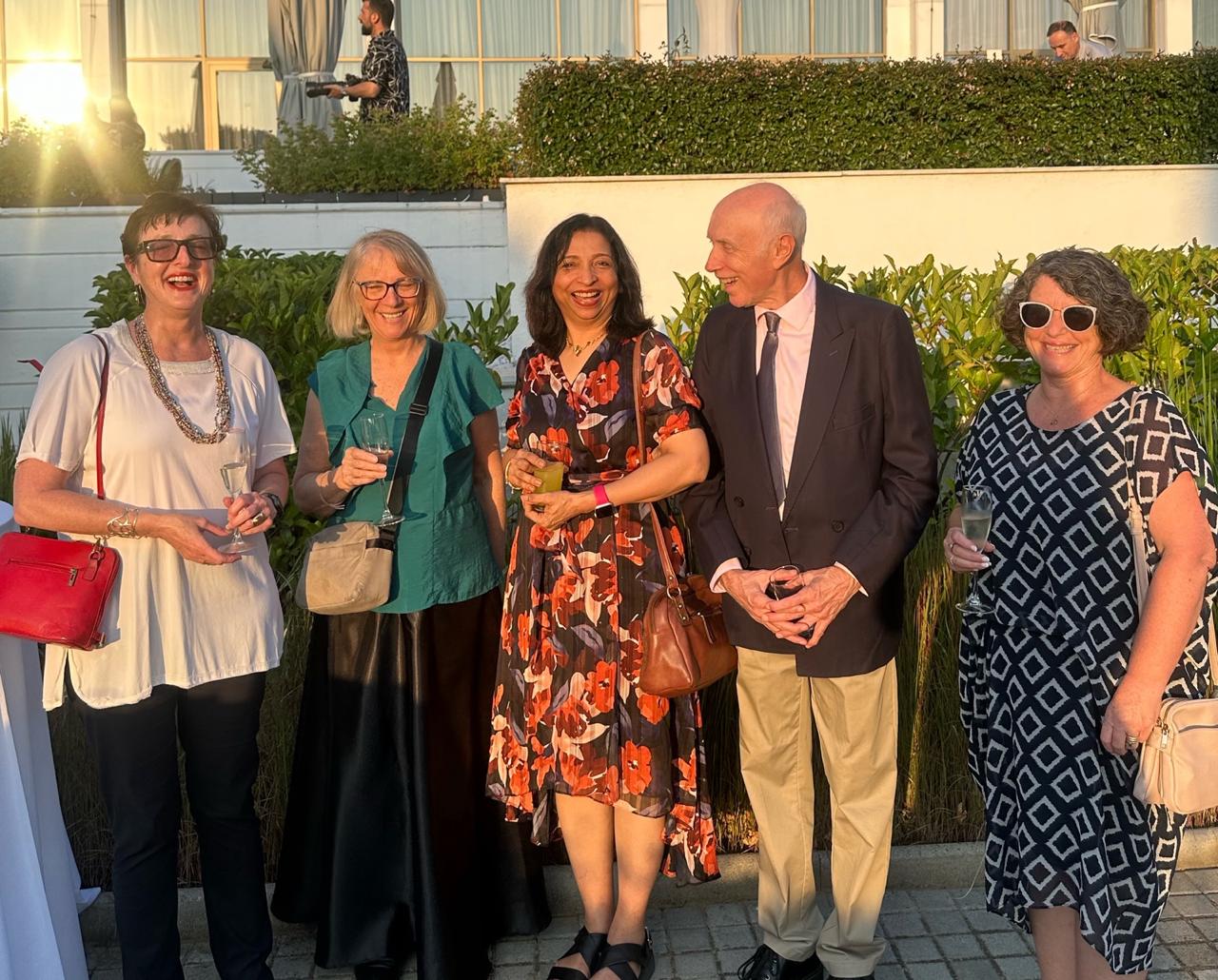
Pre-gala sunset drinks. Pictured from left: Virginia Turner (Australian Homoeopathic Association), Linlee Jordan (AP Director), Dr Sujata Naik (Clinic Director), Michael Cowdroy (AP Member), Sandra Venables (Australian Register of Homoeopaths)
Day 3
The final day of the conference has come around, and, while the brain feels very full already, it is with a sense of disappointment that I approached the day, mainly due to the feeling that it would not be very long before the uplifting sensation of being surrounded by scientists and homeopaths who are all excited for the future of homeopathy globally will soon dissipate. Thankfully I have to research and positive notes to bring with me back to Australia to share with you all and hopefully continue to inspire positiveness for our profession.
The sessions this morning were covering Fundamental research (the mode of action) and Veterinary research.
Dr Daniel Wrzalko (Poland) presented results on using chromatographic patterns on blood from patients treated with homeopathic remedies providing a potential model for measurements in basic research. Dr Michel van Wassenhoven (Belgium) demonstrated that homeopathy cannot be considered pure water! This research was not looking at nanoparticles, but at nanobubbles (they replace the nanoparticles at high dilutions). The take home message included:
1. the presence of nanoparticles in homeopathic medicines has been established
2. the particle size distribution depends on the raw material used and its manufacturing method
3. a dynamisation is not a simple dilution
4. initially, the particles are a mixture of matter and nanobubbles. The nanomaterial is gradually replaced by nanobubbles of the same size
Exciting research, and in the use of measurements of light it was easy to see the differences between water and remedies.
The session ended with the Veterinary research. Dr Ritika Narula (India) demonstrated that homeopathy, specifically Ars 6C, may be recommended to treat neonatal calf diarrhoea to rapidly resolve the issue. This study also highlighted the cost benefit of implementing homeopathy to reduce loss in the diary industry, and also to reduce antibiotic use.
Dr Cideli Coelho gave a fascinating study of the treatment of a parasite (platynosomiasis) in a population of non-human primates, marmosets, (Callitrix spp) using the biotherapeutic Platynosomum sp 30CH). This parasite affects the liver and bile duct. The results were monitored using ultrasound demonstrating the absence of alterations in the organs after 90 days in 24 of the 36 animals. The aim is to introduce this to the wild population through water sources.
Prof Patrizia Bricarello (Brazil) completed the session by reinforcing the concept introduced to us by Prof Boff of promoting One Health in agrosystems, the interactions between animals, plants, humans and the environment. She also highlighted the theme of overuse of antibiotics, outlining that 80% of antibiotic use is in animals. The university (Federal University of Santa Catarina) supports her work in homeopathy as well as the Blue Sheep project, where local women are creating products from the wool of the organically raised (using homeopathy) sheep. Her work has also resulted in a product that may be of use on Australian farms too, a cream that treats sheep for myiasis (blow fly infections). The results demonstrated that this is highly effective in treating this awful infection in sheep. The summary is that homeopathy is a viable and safe option to utilise in agro-ecosystems.
The conference ended with a final lunch and chance to network. I could definitely see a hesitancy of all to say our final farewells until the next time. Overall, the conference has been well worth the long journey. The inspiration, the research, the connections old and new and the ongoing discussions have been heartwarming, uplifting and strengthening. I am returning to Australia with a positive vibe for our future within Australia and I would highly recommend a visit for all in 2027!
